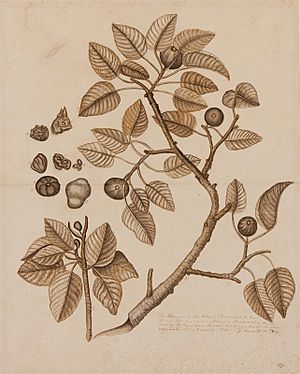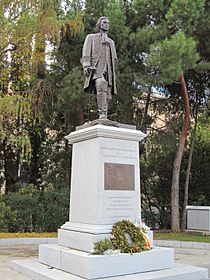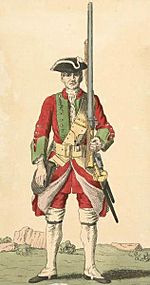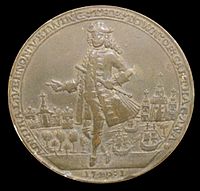Battle of Cartagena de Indias facts for kids
Quick facts for kids Battle of Cartagena de Indias |
|||||||
|---|---|---|---|---|---|---|---|
| Part of the War of Jenkins' Ear | |||||||
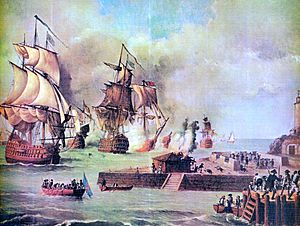 British attack on Cartagena de Indias by Luis Fernández Gordillo. Oil on canvas, Naval Museum of Madrid |
|||||||
|
|||||||
| Belligerents | |||||||
| Commanders and leaders | |||||||
| Edward Vernon Thomas Wentworth John Grant † Charles Knowles |
Sebastián de Eslava Blas de Lezo Jose Polanco Campuzano Carlos Desnaux |
||||||
| Strength | |||||||
|
27,400–30,000 military personnel:
22 frigates 71 sloops-of-war 2 hospital ships 80 troop ships 50 merchant ships |
3,000–4,000 military personnel:
|
||||||
| Casualties and losses | |||||||
| 9,500–11,500 dead 7,500 wounded and sick 1,500 guns lost 6 Royal Navy ships lost 17 Royal Navy ships of the line heavily damaged 4 frigates and 27 transports lost |
800 dead 1,200 wounded 6 ships lost 5 forts 3 batteries |
||||||
The Battle of Cartagena de Indias was a major fight between Spain and Great Britain. It happened from March to May 1741. This battle was part of a bigger conflict called the War of Jenkins' Ear.
The war started because of trade problems between the two countries. Britain wanted to control important Spanish ports in the Caribbean Sea. These ports included Porto Bello and Chagres in Panama, Havana, and Cartagena de Indias in what is now Colombia.
Britain had tried to attack Cartagena twice before in 1740, but they failed. For their third try in 1741, they launched a huge attack with both ships and soldiers. However, the British were forced to leave after many failed attempts. They lost over 9,500 to 11,500 soldiers, mostly due to sickness. They also lost a lot of equipment.
This victory showed that Spain could defend its lands. It also largely ended the fighting in this part of the world. Both countries then focused on a bigger war in Europe called the War of the Austrian Succession. The fighting officially ended in 1748 with the Treaty of Aix-la-Chapelle.
Contents
Why the Battle Happened: Trade and Tensions
A peace agreement in 1713, called the Treaty of Utrecht, allowed British traders to access Spanish colonies in the Americas. Before this, Spain kept these colonies closed off. The treaty gave Britain special rights. These included the Asiento de Negros, which was a monopoly to supply 5,000 enslaved people each year to Spanish America. Britain also got the Navio de Permiso, allowing two ships a year to sell goods in Porto Bello or Veracruz.
These trading rights were given to the South Sea Company. The British government took over this company later. In the 1700s, European countries often fought over trade. They believed there was only a limited amount of trade available. This meant if one country's trade grew, another's had to shrink. So, governments tried to stop foreign competition.
It was very expensive to use these official trade routes. Most of the profit came from smuggling illegal goods. This meant Spain lost a lot of money from taxes. Spain also felt that the South Sea Company was making huge profits but not paying Spain its share.
Spain was also upset that Britain controlled Gibraltar and Menorca. These areas were confirmed to be British by the Treaty of Utrecht. Spain tried to take back Gibraltar in a war from 1727 to 1729. Britain also tried to block trade at Portobello. Both attempts failed, and the countries made peace. But the main problems causing the conflict were not solved. British traders wanted easier access to the rich Spanish markets in the Caribbean. There was a big demand for goods there, which led to a large illegal trade.
Spanish guards were allowed to search British ships trading with their colonies. In 1731, during one such search, a British captain named Robert Jenkins claimed a Spanish officer wounded him. This helped convince the public to support a war with Spain. Many people in Britain wanted war. This was partly to remove Robert Walpole, the long-serving Prime Minister. It was also because they wanted more trade in Spanish America. On October 23, 1739, Britain declared war on Spain.
Spanish Caribbean Ports
The Spanish Caribbean trade relied on four main ports: Vera Cruz, Cartagena, Porto Bello, and Havana. Havana was the most important. It was where all the trade from the other three ports came together. On November 22, 1739, the British captured Porto Bello. This attack was meant to hurt Spain's economy.
Six British ships, led by Vice-Admiral Edward Vernon, attacked the poorly defended port. The British easily captured the city, though they left it soon after. This victory made people in Britain very happy.
Vernon was given command of a quarter of the Royal Navy. This was part of a large combined attack with both navy and army forces. The overall commander was Lord Cathcart. The first goal was to capture Havana. Havana was the most important Spanish port because it had ship repair facilities. By 1740, it was Spain's largest shipyard.
Lord Cathcart died on the way to the Caribbean. This caused confusion about who was in charge. His death led to disagreements among the British commanders. This made it hard for them to work together for such a big operation.
The British public, especially traders, had demanded this large fleet and army. The South Sea Company refused to accept any peace deals. The Duke of Newcastle supported the public's demands in Parliament. Vice-Admiral Vernon strongly supported the war against Spain. He pushed for attacks both in Parliament and to the British Navy leaders.
The decision for a large expedition to the West Indies was made in December 1739. Prime Minister Walpole, who was against the war, and Vernon, who preferred smaller attacks, were both unhappy. Vernon was not sure a large attack on a strong city like Cartagena would work. He worried that a long siege would lead to many deaths from disease. This was a common problem at the time due to limited medical knowledge.
British Goals
Britain wanted to capture and hold Spain's four main ports in the Caribbean. By controlling these ports, Britain would control the entry and exit routes to South America. They would have bases to attack inland. Spain would have limited access to deep water ports on the eastern coast of their colonies. This would make it hard for Spain to resupply its forces.
Controlling these ports would also give Britain a place to attack the rest of the Spanish Empire in the Americas. However, Britain did not have a place to build and repair ships in the Caribbean, unlike Spain's shipyards in Havana. Without a shipyard, no fleet could stay in the area for long without breaking down. Capturing Havana and its dry dock quickly was very important. Newcastle and Sir Charles Wager, the head of the Admiralty, preferred Havana as the first target. But the British government was divided. So, the decision was left to Vernon and others at a meeting in Jamaica. They followed Vernon, who chose Cartagena as the first target. It was a good port and easy to reach from Britain's existing Caribbean bases. Vernon thought Havana was too well defended to be the first target.
Cartagena de Indias: A Strong City
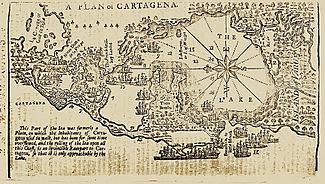
Pedro de Heredia founded Cartagena of the Indies in 1533. In the 1700s, it was a large, wealthy city with over 10,000 people. It was the capital of the Cartagena province. It had strong defenses that had been recently fixed and improved. These included forts, batteries, and other structures. Its harbor was considered one of the best in the world. Spanish ships used it to gather gold and silver from New Granada and Peru before sailing to Spain.
The shallow waters near the city walls made it impossible to attack directly from the sea. Also, the high water level made digging difficult. This exposed soldiers who were not used to the climate to diseases.
After an English force led by Sir Francis Drake captured Cartagena in 1585, its defenses were rebuilt. But they were neglected, allowing a French privateer to sack the town in 1697. However, Juan de Herrera y Sotomayor largely rebuilt Cartagena's defenses before he died in 1732.
The city faces the Caribbean to the west. To the south, its bay has two entrances: Boca Chica (Little Mouth) and Boca Grande (Big Mouth). Boca Chica was the main deep-water entrance. It was so narrow that only one ship could pass at a time. This entrance was protected by Fort San Luis on one side. It had smaller defenses on the Tierra Bomba peninsula. On the other side was the Baradera battery.
Beyond Boca Chica was a lagoon that led to the inner harbor. This channel was also defended by forts on two peninsulas. The city walls themselves had about 160 cannons. The suburbs had 140 guns. A moat surrounded the city, and its gates were guarded by new bastions. The suburbs also had a moat. On a hill south of the city stood Fort San Lazaro. It was a square fort with three half-bastions. This fort overlooked the city and the surrounding plain. Another small hill nearby protected the fort. However, there was no fresh water source outside Cartagena and the fort. The best landing spot was Texar de Gracias beach, about three miles from Fort Lazaro.
The Battle Begins
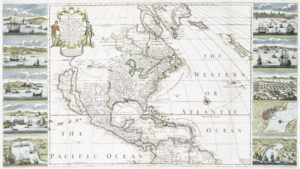
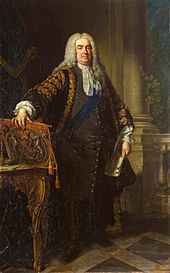
The British invasion force was huge. It had 124 ships, including 29 large warships, 22 smaller warships, 2 hospital ships, and many other vessels. They had about 2,000 cannons in total. There were also 80 ships to carry troops and 50 merchant ships.
The British had at least 27,400 soldiers and sailors. The land force had 12,000 men. This included two British regular army groups, 6,000 new marines, and about 3,600 American colonial troops. These American troops came from North American colonies on 40 other ships. They were led by Colonel William Gooch.
The Spanish force defending Cartagena was much smaller. It had 2,700 to 3,000 regular Spanish soldiers. These soldiers had just arrived in October 1740. There was also a local army group from Cartagena, an unknown number of sailors, 5 companies of local fighters, and 600 Indian archers. In total, there were perhaps 4,000 to 6,000 defenders. They had six warships and many shore-based cannons. The Spanish forces were led by Governor General of Cartagena, Blas de Lezo, and the Viceroy of New Granada, Sebastián de Eslava.
Getting Ready for Battle
The British expedition left Britain very slowly. Bad winds delayed them, and their food supplies ran out. Many sailors became sick. News of French and Spanish ships also caused delays. The British fleet had to be reinforced. These delays cost the British three months of valuable time.
The British navy also had too few sailors. They had to take two full army groups, the 34th and 36th, to work as ship crews. Lord Cathcart was ordered to transfer 600 of his marines to the warships.
The 3,600 American soldiers arrived in Jamaica much earlier, on December 3, 1740. They found that no food or supplies had been arranged for them. The lack of supplies and the hot climate quickly made many Americans sick. The fleet from Britain also suffered from typhus, scurvy, and dysentery. By January 1741, the land forces had already lost 500 men, including their commander Lord Cathcart. Another 1,500 were sick.
With both Cathcart and General Spotswood (who was supposed to be second-in-command) dead, command of the land forces went to Thomas Wentworth. He had no previous experience leading troops in battle. In Jamaica, 300 enslaved Africans were added to the expedition as workers. More delays happened before and after leaving Jamaica. This included a brief fight with a French group of ships. Both the British and Spanish knew that the two-month rainy season would start in May. This "sickly season" would last until November.
The Spanish had received more soldiers but were also suffering badly from diseases. Like the British, there were disagreements between Lezo and Eslava, but it did not stop their operations as much. Lezo wanted a very strong defense of the Boca Chica channel. Eslava disagreed, which led to some forward defenses not having enough men. This made it easier for the British to land.
Attacking Fort San Luis at Boca Chica
The British expedition arrived near Cartagena on March 13. There was no single overall commander. Decisions were made by meetings of war leaders. General Wentworth led the land forces, and Vernon led the sea forces. The navy had lost so many sailors to diseases that one-third of the land forces were needed to help crew the ships.
The city of Cartagena faced the ocean on one side. But the shore was too rough for ships to approach from the sea. The other entrance, Boca Grande, was too shallow for large ships. The Boca Chica channel was the only deep passage into Cartagena's harbor. It ran between two narrow peninsulas. On one side, it was defended by Fort San Luis, Boca Chica Castle. This fort had 49 cannons, 3 mortars, and 300 soldiers. A chain stretched across the channel to Fort San Jose on the southern peninsula. Fort San Jose had 13 cannons and 150 soldiers. Six Spanish warships also helped defend the entrance.
Before landing, Vernon silenced some smaller Spanish forts. After attacking a fort on the Barú Peninsula, the British planned to land near Boca Chica. They sent 300 elite soldiers first. Spanish defenders in two small forts, San Iago and San Philip, were driven away by three British ships. One British ship, the Shrewsbury, lost 100 men and was badly damaged.
The elite soldiers landed that evening. On March 22, the rest of the British land forces followed. This included two regular army groups and six marine groups. Only 300 American soldiers were allowed ashore. Most of the American troops had been sent to serve on the warships to replace Vernon's lost sailors. The British artillery arrived a few days later.
After setting up camp, the Americans and Jamaicans built a battery in two weeks. Its twenty 24-pounder guns began firing at the fort. Five British ships also tried to bombard the fort for two days. But they had little effect and lost many men. Three of their ships were heavily damaged.
The British cannons on land fired day and night for three days. They made a hole in the main fort. Part of the British fleet helped. Another part of the fleet fought the Spanish ships. Lezo sank two of his own ships and set another, the Galicia, on fire. The two sunken Spanish ships partly blocked the channel. The British captured the Galicia before it could sink.
The British attacked Fort San Luis by land and sea on April 5. The soldiers moved forward to the hole in the wall. However, the Spanish had already moved back to defenses in the inner harbor. Over the next week, the British landing force got back on their ships and entered the harbor. This attack on Boca Chica cost the British army 120 men killed or wounded. Another 250 died from yellow fever and malaria, and 600 sick were sent to hospitals.
Attacking Fort San Lazaro
The British leaders decided to try to cut off Cartagena from the land. They planned to attack Fort San Lazaro. After capturing San Luis and other outer defenses, the British fleet sailed through Boca Chica into the harbor. The Spanish moved their forces to Fort San Lazaro and the city.
Vernon pushed Wentworth into a poorly planned attack on Fort San Lazaro. This fort was a key defense point for Cartagena. Vernon refused to support the attack with his ships, giving excuses about the harbor's depth. The ships cleared the beach with cannon fire, and Wentworth landed on April 16.
After the British entered the inner harbor and captured some outer forts, de Lezo strengthened Fort San Lazaro. He dug a trench around it and cleared the area for better shooting. He had to hold the fort because it overlooked the city. If the British captured it, they could bombard Cartagena and force it to surrender quickly. Lezo defended the trench with about 650 soldiers. He put another 300 soldiers inside the fort. He also kept 200 marines and sailors ready as backup.
The British advanced from the beach. They had to pass through a narrow path. There, they met a Spanish force that fought briefly before retreating.
The only British engineer on the expedition had been killed at Fort San Luis. No one could build a battery to break through the fort's walls. The British decided to storm the fort directly in a surprise night attack. A night attack would allow them to assault the northern side of the fort facing Cartagena. In the dark, Cartagena's guns would not be able to help. The southern side had the lowest and weakest walls. Elite soldiers would try to quickly storm the walls there.
But the attack started late. The first advance on Lazaro began near dawn, at 4 AM on April 20. It was led by 50 chosen men, followed by 450 elite soldiers. The main force was 1,000 men from two army groups. Then came a mixed group and some unarmed Americans carrying ladders and wool packs to fill the trench. Finally, there was a reserve of 500 marines.
Two Spanish deserters led the British column. They misled the British on the southern, low-walled side. The elite soldiers climbed a steep slope. They were met with deadly gunfire from the Spanish at close range. The soldiers spread out and slowly exchanged fire. On the north side, the leader fell early, and the leaderless troops also exchanged fire with the Spanish. Most of the Americans dropped their ladders and took cover. The ladders that were brought forward were too short by ten feet.
After an hour, the sun rose. Cartagena's guns began firing at the British, and more soldiers were wounded or killed. At eight o'clock, a column of Spanish soldiers came from Cartagena's gates. They threatened to cut off the British from their ships. Wentworth ordered a retreat. The attack failed. The British lost 600 men out of about 2,000. Sickness and disease caused even more losses. During the attack on Fort San Lazaro, Wentworth's land forces dropped from 6,500 to 3,200 healthy men.
British Retreat
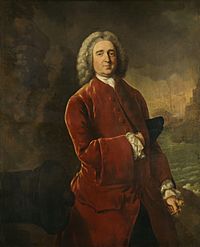
Don Blas de Lezo's plan was to fight and retreat slowly. He wanted to delay the British until the rainy season started at the end of April. The heavy tropical rains would stop fighting for two more months. Also, the longer the enemy stayed crowded on ships and in the open, the more they would suffer from lack of supplies, discomfort, and especially disease. These would become Lezo's allies and the British's deadly enemies.
De Lezo was helped by the fact that Vernon and Wentworth disliked each other. This stopped them from working together after the first landing. Another important reason for the British defeat was that Cartagena's defenses had been repaired and improved over the past year. Even though De Lezo was pushed to his limits, his plan worked, and the Spanish won.
The rains came, and the British had to go back to their ships. On the crowded ships, disease spread even faster. By April 25, Vernon and his leaders decided to retreat to Jamaica. By mid-May, they were gone. By May 7, only 1,700 men of the land forces were healthy enough to fight. Only 1,000 were strong enough to land against the enemy. Within a month of leaving Cartagena, another 1,100 men died. British strength was reduced to 1,400, and American strength to 1,300.
The expedition and battle lasted for 67 days. It ended with the British fleet leaving in defeat. They lost 18,000 men who were either dead or too sick to fight, mostly from disease. The Spanish also suffered greatly from disease, including Blas de Lezo himself. He died a few weeks after getting sick from a plague. In addition, 50 British ships were lost, badly damaged, or abandoned because they had no crews. Nineteen large warships were damaged, four smaller warships, and twenty-seven transport ships were lost.
Of the 3,600 American colonists who volunteered, hoping for land and gold, most died from yellow fever, dysentery, and starvation. Only 300 returned home. One of them was Lawrence Washington, who later renamed his Virginia plantation, Mount Vernon, after Admiral Vernon.
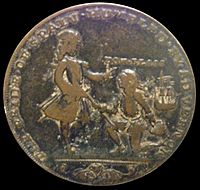
Early in the battle, when the Spanish forces had moved back to Fort San Lazaro, Vernon thought he had won. He sent a messenger to Britain to tell King George that British forces had entered the inner bay. People who made souvenirs had already started making medals to celebrate a victory that never happened. These medals were mostly made by button-makers and were often of poor quality. The largest collections of these medals are in the United Kingdom and the United States. Special china was also made, but less of it has survived. One medal showed Admiral Vernon looking down on the "defeated" Spanish admiral Don Blas de Lezo, who appeared to be kneeling. A sailor from the Shrewsbury even wrote a song celebrating the victory too early.
The main reasons for the British defeat were:
- The British failed to find a single leader after their commander, General Charles Cathcart, died.
- They could not land heavy cannons and ammunition close to Cartagena.
- Vernon's actions prevented his warships from supporting the soldiers.
- The Spanish leaders, Viceroy Sebastián de Eslava, Admiral Blas de Lezo, and Colonel Carlos Suivillars, carried out effective plans.
There is no proof for a story that Admiral Vernon sent a letter to Blas de Lezo saying he would return with more ships. And that Lezo supposedly replied that the English King would need a much bigger fleet.
What Happened Next
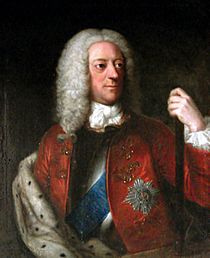
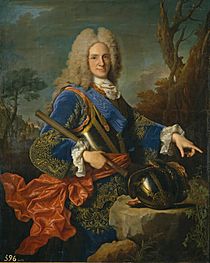
After news of the disaster, Robert Walpole's government soon fell apart. Spain kept control of its most important colonies. This included the vital port in the Caribbean. It helped protect the Spanish Main and its trade with Spain across the Atlantic Ocean.
News of Britain's defeat reached Europe in late June 1741. It had a huge impact. It caused George II of Great Britain to withdraw Britain's promise to support Austria. This was about Austria's claim to a territory called Silesia. This encouraged France and Spain, who were allies with Prussia, to attack Austria, which was now alone. A bigger war, the War of the Austrian Succession, then began.
The huge losses suffered by the British affected all of Vernon's and Wentworth's later actions in the Caribbean. Most of them failed badly. This happened even with 1,000 more troops from Jamaica and 3,000 regular soldiers from Britain. Vernon and Wentworth were both called back to Britain in September 1742. Chaloner Ogle took command of a very sick fleet. Less than half of its sailors were healthy enough to work. By the time the Caribbean campaign ended in May 1742, ninety percent of the army had died from fighting and sickness. Several other British attacks happened in the Caribbean, but they did not change the overall situation much. The weakened British forces made raids on the Venezuelan coast. They attacked La Guaira in February 1743 and Puerto Cabello in April. But neither attack was very successful.
The failure to take Cartagena meant that the naval forces with Vernon had to stay in the Caribbean longer. This weakened the British fleet in the Mediterranean Sea. Because of this, the Spanish were able to send 25,000 troops to Italy twice in late 1741. It was not until Commodore Richard Lestock returned to Europe with ships from the Caribbean fleet that Britain strengthened its presence in the Mediterranean.
Historian Reed Browning called the British Cartagena expedition "stupidly disastrous." He quoted Horace Walpole, who wrote in 1744: "We have already lost seven millions of money and thirty thousand men in the Spanish war and all the fruit of all this blood and treasure is the glory of having Admiral Vernon's head on alehouse signs." The words on Vernon's memorial in Westminster Abbey show the bitter disagreement between the navy and army at Cartagena. It says: "He subdued Chagre, and at Carthagena conquered as far as naval forces could carry victory."
In 2014, during his visit to Colombia, Prince Charles and city officials revealed a plaque. It honored the British soldiers who died in the battle. But city residents complained that the Spanish defenders were not mentioned. The plaque was also placed near a statue of de Lezo. So, the city officials decided to remove the plaque, which had already been damaged. Mayor Dionisio Velez said he did not mean to "stir this controversy, or hurt the feelings of people."
Popular Culture
The Scottish folk/pirate metal band Alestorm has a song called "1741 (The Battle of Cartagena)." It is on their 2014 album Sunset on the Golden Age and tells the story of the battle.
See also
 In Spanish: Sitio de Cartagena de Indias (1741) para niños
In Spanish: Sitio de Cartagena de Indias (1741) para niños


